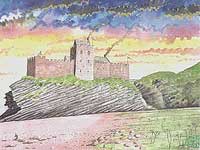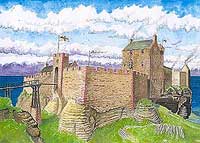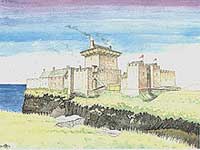|
History of Caithness |
|
Index & Introduction Page One Page Two Page Three Page Four Page Five Page Six Page Seven Page Eight |
|
Civil And Traditional |
|
From
Braemore to
Berriedale the character of the
scenery partakes more of the mountainous feature of Sutherland than
of the generally tame level aspect of Caithness. Berriedale
is, beyond all comparison, the sweetest spot in the county. It is
the Tempe of Caithness, and has been likened to a beautiful Swiss
scene in miniature. The unique and charming appearance of the
romantic dell, with its steep and richly-wooded banks, together with
the air of profound seclusion that reigns around it, would at first
sight almost make one think that he was gazing not on an actual spot
of earth, but on a scene in fairy land. The two rivers of Langwell and Berriedale, the one rising in the heights beyond Braemore, and the other in the wilds of Kildonan, meet immediately below the inn, and soon after discharge their united current into the small haven, which is about a hundred yards or so from the head of the glen. This feature of the scene reminds one of Moore’s beautiful poem, “The Meeting of the Waters.”
The only towns in the county are Wick and Thurso. Wick, which may be considered the capital, is situated close by the sea, at the mouth of the river which bears its name. The term Wick, which is of pure Scandinavian origin, and signifies an opening, or bay, is quite descriptive of the situation of the town. In ancient times the place was much frequented by the Northmen; and a colony of those daring adventurers would seem to have formed an early settlement in it and the neighbourhood. Indeed, with the exception of, perhaps, Canisbay, there is no parish in Caithness that indicates more clearly the impress of the Norwegian colonisation than that of Wick. The town was erected into a royal burgh by James VI. of Scotland, in the year 1589; and the set, as it is termed, consists of a provost, two bailies, a dean of guild, a treasurer, and seven councillors. This municipal honour, with its accompanying privileges, was conferred on it at the request of the then Earl of Caithness. Although at this period it could have been only a mean-looking village, consisting of a few thatched houses, it would appear to have been a place of some little trade; for in an inroad of the Sutherland men in 1588, it is said, that among other acts of spoliation, they plundered the ship and carried away the goods of one Andrew Wardlaw, a merchant in the town. From the date of its charter to the Union in 1707, Wick sent a commissioner to the Scottish Parliament. At the Union it was associated with Kirkwall, Dornoch, Tain, and Dingwall, in the return of one member to the British House of Commons. In 1832, when the Reform Act was passed, Cromarty was added to this batch; and Wick, comprehending within its parliamentary bounds the suburban village of Louisburgh, and Pulteneytown, was constituted the returning burgh. The Earls of Caithness held the superiority till 1672, when Glenorchy purchased it. He afterwards sold the superiority to the Ulbster family; and in 1821 Sir John Sinclair disposed of it to the Duke of Sutherland for £3500. This municipal privilege, which formerly gave the superior so much political influence in the burgh, has now become of little value. Of late years, the appearance of the town has been very much improved by the erection of a number of excellent new houses and shops. The Town and County Hall, and the Commercial Bank are two very handsome public buildings. The latter is built entirely of freestone, and ornamented in front with Ionic pillars. Dr Sinclair, of Wick, who has directed much attention to the natural history of the county, has a very fine museum, which will well repay a visit. This valuable and interesting collection of curiosities is particularly rich in the department of ornithology. It contains upwards of 200 birds indigenous to the county, besides a great variety of quadrupeds, insects, and fishes, all beautifully prepared and arranged by this ingenious gentleman himself. It includes also a number of rare coins, and medals of different countries, many of them of great antiquity. Amongst other objects of interest, there are two deserving of special notice. The one is the petrified tongue of an animal found some years ago at John O’Groat’s, and differing in form from that of any quadruped which at present is known to exist.
Pulteneytown, on the south side of the bay and river, consists of two parts, the upper and lower. In the latter is the harbour. Upper Pulteneytown stretches eastward on an elevated terrace along the sea bank, and occupies a fine airy situation. It is regularly laid out in streets with a square near the centre. The houses are built of the blue Caithness flagstone which, it must be confessed, gives to the whole a somewhat sombre appearance. The principal public building is the Academy, near the upper end of Sinclair Terrace. It stands conspicuously on a high brae looking down on Lower Pulteneytown. It was erected in 1838 by the British Fishery Society at an expense of about £1600. It has had several eminent teachers, and among others, Mr Andrew Scott, the present professor of oriental languages in King’s College, Aberdeen, was a short time rector of the institution. Pulteneytown and Wick proper are connected by a bridge of three arches flung across the river not many yards from where it runs into the bay. Before the erection of this bridge about the year 1800, the principal access to the town from the south side of the river was by a foot bridge which consisted of eleven pillars of stone connected by planks. In 1665 a complaint is made against the shoemakers and glovers of the burgh for breaking down the bridge by dressing skins and leather on it. The population, including that of Pulteneytown and Louisburgh, is about 7475. There are two newspapers published in Wick—the John O’Groat Journal, and the Northern Ensign. The former was started in 1836, and the latter in 1850. Both advocate Liberal views in politics; both are conducted with much spirit and ability, and have each a respectable circulation. Wick derives its chief importance from being the great emporium of the herring fishery in Scotland; and a brief account of its rise and progress may not be uninteresting. Its founders were John Sutherland, of Wester, John Anderson, of Wick, and Alexander Miller, of Staxigoe. They fitted out two small sloops, on the bounty, and began to fish in 1767; hut, from various causes, the speculation was not very encouraging, and comparatively little was done till 1786, when the British Fishery Society was incorporated by Act of Parliament. The first fishing station was at Staxigoe, a pretty large creek, not far from Nosshead—there being then no harbour at Wick except the mouth of the river. In 1790 there were thirty-two small sloops fishing on the bounty. The bounty allowed was fifty shillings per ton. Afterwards boats began to be used; and in 1795 no fewer than 200 small boats were fishing at Wick, but great inconvenience was suffered from the want of a harbour. In 1808 the British Fishery Society commenced their establishment of Pulteneytown by making a harbour and granting feus in perpetuity, for building, on liberal terms. The ground on which the town is situated was purchased by the British Fishery Society from Lord Duffus, and it was called Pulteney in honour of Sir William Pulteney, who was chief director or governor of the Society at the time of the purchase. In 1810 the inner harbour was completed, at an expense of £16,000, of which £7500 were defrayed by Government. Owing to the great increase of trade, an outer harbour was planned in 1824, and in 1831 completed, at an expense of £22,000. The quantity of herrings caught, and the number of persons engaged, vary each year considerably. “On an average,” says a writer on the subject, “it may he stated that the quantity caught during the season may he from 100,000 to 120,000 barrels or crans, and the number of people partially or wholly employed, including fishermen, coopers, packers, etc., about 12,000.” Numbers of fishermen come from the western isles—from Orkney and Shetland, and from the counties of Sutherland, Ross, Moray, Banff, etc. The number of boats is generally about 1000, each with a crew of five or six hands. Sometimes they have amounted to 1100; and, on a fine evening in July or August, the scene presented by this large fleet of boats leaving the harbour, and spreading over the bay in full sail, is truly magnificent. The cost of each boat, with nets and appurtenances, is about £150; and the netting of the whole fleet, if lineally extended, would stretch, it is said, from the Pentland Firth to the English Channel! For the export of fish, shipping resort to the port of Wick alone to the extent of 60,000 tons a-year. The annual value of herrings exported may be estimated at £150,000. According to the report of Tucker, one of the commissioners appointed by Cromwell to arrange the customs and excise in Scotland, Wick in 1654 did not possess a single vessel of any description. Thurso had just one small craft of 30 tons, and a Custom House officer was stationed in the county for looking after that town and Wick. “From these two ports,” says Tucker, “a good store of beef, hides, and tallow is usually sent coastwise.” But, he adds, “The officer’s work is rather for preventing these commodities from being sent into foreign parts than from anything he is likely to recover, here.” The number of vessels at present belonging to Wick and Pulteneytown is 56, fitted to carry 3386 tons. The harbour accommodation is still greatly inadequate, and it is, moreover; unfortunately exposed to a heavy swell from the bay when the wind blows from the east, which renders the entrance to the port extremely dangerous. Both harbours, too, have sanded up to a great extent; and there is not sufficient depth of water for the Aberdeen steamer to enter at any time. In the fall of the season, the coast is frequently visited by great and sudden outbursts of storm. The morning of the 19th August, 1848, will long be remembered in Wick. The sky on the preceding evening had a very unfavourable appearance about sunset, especially towards the east, where a mass of dark lurid cloud, streaked with fiery red, hung around the horizon, like a warning signal of the coming gale. The barometer, too, was observed to have fallen considerably. Notwithstanding these ominous prognostics, a number of boats left the harbour, and proceeded to the fishing ground. Early in the morning the threatened storm burst forth with all the suddenness and fury of a tropical hurricane. The wind blew from the south-east with the utmost vehemence. Houses shook, and windows rattled, and families were roused from their slumbers by the unusual noise. Hundreds in the first moments of alarm ran to the harbour. The bay was fearfully agitated; and the heavy surge ever and anon broke over the bar, sweeping everything before it. Consternation was painted in every countenance. It was an appalling scene, deepened into tenfold intensity by the distress and agony of those who had relatives in the tiny craft that were dimly seen at times tossing on the crests of the foaming billows, and making for the shore, which was surrounded with a tremendous surf. Destruction was imminent, and no power of man could avert it. On that fatal morning forty-one boats were lost, and no fewer than thirty-seven men perished, many of them within a few yards of the harbour. Next to Wick, the most important fishing station in the county is Lybster, which contains a population of about 800. The number of boats in the fishing season is upwards of 200. The village, which is near the sea, is provided with an excellent harbour, and the inhabitants are distinguished for their public spirit and enterprise.
|
|
Index & Introduction |


